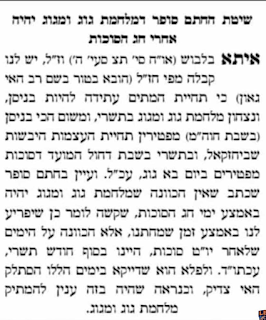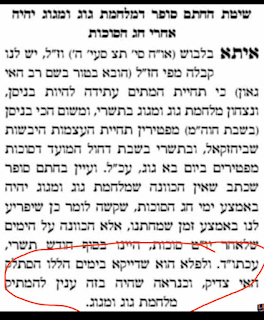Sunday, October 15, 2023
When Sheker met Pachsa
Friday, October 13, 2023
Miracles: The Holtzberg Torah and this week's Haftorah
Ht: Yosef
A Torah dedicated to Gavriel and Rivka Holtzberg, the victims of the 2008 Mumbai terror attacks, has been donated to the IDF and will be accompanying the soldiers as they go in to rescue hostages.
The Haftorah for Parshat Bereishis is Isaiah 42:5 - 43:10
פקוד פקדתי
HT: Yosef
Before Yaakov Avinu passed away, he called his grand-daughter Serech bas Asher to him. He had blessed her with a long life and knew that she would be the only one from his generation who would still be alive to witness the Redemption from Egypt. He told her that when the true Redeemer arrives he will use the words פקוד פקדתי - P'kad p'kaditi
She was instructed to keep the words a secret.
When Moshe Rabbeinu came to the zekkeinim, he told them 'Hashem told me פקוד פקדתי'.
They went with these words to Serach who told them that these are the words that signify that Geula is finally here.
The words פקוד פקדתי are also gematria תשפ״ד - 5784
The Rope of Moshiach
Rav Refael Dovid Auerbach [the brother of Rav Shlomo Zalman] related that over 90 years ago his father, Rav Chaim Leib Auerbach, once approached one of the caretakers who used to light the stove in a shul in the Old City of Yerushalayim. Although the caretaker was over 95 years old, he awoke early each day to light the stove and heat the shul before davening. The caretaker mentioned that his father used to travel to see Rebbe Elimelech of Lizhensk. Rav Chaim Leib asked the caretaker if he could relate anything his father had told him about the Tzaddik. The elderly man told him ten stories about the author of Noam Elimelech. Later Rav Chaim Leib told all of them over, but Rav Rafael could remember only three of them.
Thursday, October 12, 2023
Chizuk
HT: DL
I don't know who this man is, but he's very powerful. If you know who it is, please leave a comment.
Updated: It is Rabbi Shlomo Farhi.
The 50th Level of Tumah [Impurity]
Transcription now available: The Transformation of Reality in the Messianic Era
Rabbi Mendel KessinWednesday, October 11, 2023
Clear Prophecy
HT: Yosef
 |
| The Chatam Sofer |
5784 - A Message from the Past
HT: Yosef
Tuesday, October 10, 2023
The Final Exile of Yishmael
Monday, October 9, 2023
Ain Od Milvado
"There are three matters that come only by means of diversion from attention of those matters, and these they are: The Moshiach, a lost item, and a scorpion." Sanhedrin 97a [Source]
The scorpion is Hamas, and now we await Moshiach.
I feel that the fact it was exactly 50 years since the 1973 Yom Kippur war - and both wars were surprise attacks - is a sure sign of the Hand of Hashem here.
Rabbi Kessin says we are at the 50th level of Tumah.... and the window is almost closed.....I didn't think the world could exist at the 50th level, but there's that number 50 again.
The sun shall be turned into darkness, and the moon into blood, before the great and terrible day of the LORD come. [Yoel 3:4]
There is a "ring of fire" eclipse of the sun on October 14, and a lunar eclipse on October 28, when the moon is likely to turn red. More information at https://timesofindia.indiatimes.com/astrology/planets-transits/solar-and-lunar-eclipse-in-october-2023-date-time-and-how-to-watch/articleshow/104244044.cms
However, the moon has been red and orange quite a lot lately, in various parts of the world, and at various times of the night.
This is not a normal world war, this war includes mini-wars inside many countries where Jews and Jihadists live. It's already started here.
Everyone will see that there is nowhere to turn - except to Hashem. It's not going to take too long, the way it's playing out.
 |
| Photo JK |
Sunday, October 8, 2023
8th Day
I'm horrified at everything happening right now.
Shemini Atzeret, celebrated together with Simchat Torah in Israel [and over two days outside of Israel] is known as the "8th day" of Succot.
8 of course represents the Messianic Era.
I don't have too much to say about this, I'm not in Israel, I'll leave the talking to the Israelis.
Australia officially stands with Israel, thank G-d. Tomorrow night the Sydney Opera House will be lit up in the Israeli colours of blue and white to show support and solidarity.
May this be the final war, and may we see the coming of the Moshiach very soon.
Friday, October 6, 2023
What is Hoshana Raba?
 |
| Willow tree - ''Aravah'' |
The seventh day of Sukkot is called Hoshana Rabbah, and is considered the final day of the Divine “judgment” in which the fate of the new year is determined. It is the day when the verdict that was issued on Rosh Hashanah and Yom Kippur is finalized.
Read more : click here
Rain and Dew
Thursday, October 5, 2023
Last Night's Light Show
It rained last night. We had the system passing by, lots of rain and we needed it. Some lucky people got an amazing light show, like this one in Adelaide, South Australia. Electrical discharge from passing planets. The thick mass of purple clouds belongs to the planet Atu, turns the sky purple, purple lightning. If it's purple, Atu is in the vicinity.
 |
| Adelaide Australia October 4 2023 |
This electrical discharge from other planets is the reason why we now get storms that look like this [two months ago in Castle Rock]
Wednesday, October 4, 2023
19 Tishrei - Yarzheit of the Vilna Gaon
 |
| Painting of the Vilna Gaon from Yesodei Hatorah School corridor wall |
























